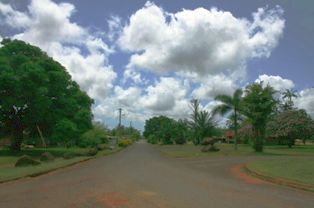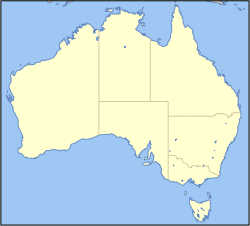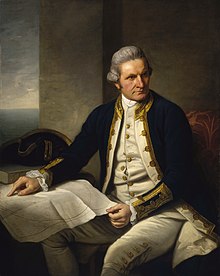Warrongo is an Australian Aboriginal language, one of the dozen languages of the Maric branch of the Pama–Nyungan family. It was formerly spoken by the Warrongo people in the area around Townsville, Queensland, Australia. Its last native speaker was Alf Palmer, who died in 1981.

The Guugu Yimithirr, also spelt Gugu Yimithirr and also known as Kokoimudji, are an Aboriginal Australian people of Far North Queensland, many of whom today live at Hopevale, which is the administrative centre of Hopevale Shire. At the 2011 census, Hopevale had a population of 1,005 people. It is about 46 kilometres (29 mi) from Cooktown by road. It is also the name of their language. They were both a coastal and inland people, the former clans referring to themselves as a "saltwater people".

Laura is a rural town and locality in the Shire of Cook, Queensland, Australia. In the 2016 census the locality of Laura had a population of 228 people.

Hope Vale is a town within the Aboriginal Shire of Hope Vale and a coastal locality split between the Aboriginal Shire of Hope Vale and the Shire of Cook, both in Queensland, Australia. It is an Aboriginal community. In the 2016 census, the locality of Hope Vale had a population of 1,015 people.
Mbabaram (Barbaram) is an extinct Australian Aboriginal language of north Queensland. It was the traditional language of the Mbabaram people. Known speakers were Albert Bennett, Alick Chalk, Jimmy Taylor and Mick Burns. Recordings of Bennett and Chalk are held in the Audiovisual Archive of the Australian Institute of Aboriginal and Torres Strait Islander Studies. R. M. W. Dixon described his hunt for a native speaker of Mbabaram in his book Searching for Aboriginal Languages: Memoirs of a Field Worker. Most of what is known of the language is from Dixon's field research with Bennett.

North Queensland or the Northern Region is the northern part of the Australian state of Queensland that lies just south of Far North Queensland. Queensland is a massive state, larger than many countries, and its tropical northern part has been historically remote and undeveloped, resulting in a distinctive regional character and identity.
Kuku-Thaypan is an extinct Paman language spoken on the southwestern part of the Cape York Peninsula, Queensland in Australia, by the Kuku-Thaypan people. The language was sometimes called Alaya or Awu Alaya. Koko-Rarmul may have been a dialect, though Bowern (2012) lists Gugu-Rarmul and Kuku-Thaypan as separate languages. The last native speaker, Tommy George, died on 29 July 2016 in Cooktown Hospital.

The Paman languages are an Australian language family spoken on Cape York Peninsula, Queensland. First noted by Kenneth Hale, Paman is noteworthy for the profound phonological changes which have affected some of its descendants.

The Shire of Cook is a local government area in Far North Queensland, Australia. The Shire covers most of the eastern and central parts of Cape York Peninsula, the most northerly section of the Australian mainland.

The Normanby River, comprising the East Normanby River, the West Normanby River, the East Normanby River North Branch, the East Normanby River South Branch and the Granite Normanby River, is a river system in Far North Queensland, Australia.

The Bloomfield River is a river in the Wet Tropics of Far North Queensland, Australia, noted for its Bloomfield River cod fish species, found only in the river.

The Cape Bedford Mission was the first Christian mission on the Cape York Peninsula of Queensland, Australia. It is the oldest surviving mission in northern Queensland. It is at South Cape Bedford within the present-day locality of Hope Vale.

Cooktown is a coastal town and locality in the Shire of Cook, Queensland, Australia. Cooktown is at the mouth of the Endeavour River, on Cape York Peninsula in Far North Queensland where James Cook beached his ship, the Endeavour, for repairs in 1770. Both the town and Mount Cook which rises up behind the town were named after James Cook.
The Kuku Nyungkal dialect is an Australian Aboriginal language and the language of the Kuku Nyungkal people of Far North Queensland. It is a variety of Kuku Yalanji still being spoken. Most of the speakers today live in the communities of Wujal Wujal and Mossman.

The Wujal Wujal Aboriginal Shire is a local government area in Far North Queensland, Australia. It is managed as a Deed of Grant in Trust under the Local Government Act 2004.
Mbariman-Gudhinma, one of several languages labelled Gugu Warra 'unintelligible speech' as opposed to Gugu Mini 'intelligible speech', is an extinct dialect cluster of Aboriginal Australian languages of the Cape York Peninsula in northern Queensland, Australia. Another one in the group is Wurangung, also known as Yadaneru or Jeteneru.
Guugu Yalandji, also spelt Kuku-Yalanji, is an Australian Aboriginal language of Queensland. It is the traditional language of the Kuku Yalanji people.

The Aboriginal Shire of Hope Vale is a local government area in Far North Queensland, Queensland, Australia, north of the town of Cooktown. The majority of the Shire consists of Deed of Grant land that is held for the benefit of Aboriginal people particularly concerned with the land and their ancestors and descendants.

Palmer is a rural locality in the Shire of Cook, Queensland, Australia. In the 2021 census, Palmer had a population of 46 people.
Mount Mulgrave is a rural locality in the Shire of Mareeba, Queensland, Australia. In the 2016 census, Mount Mulgrave had a population of 0 people.













